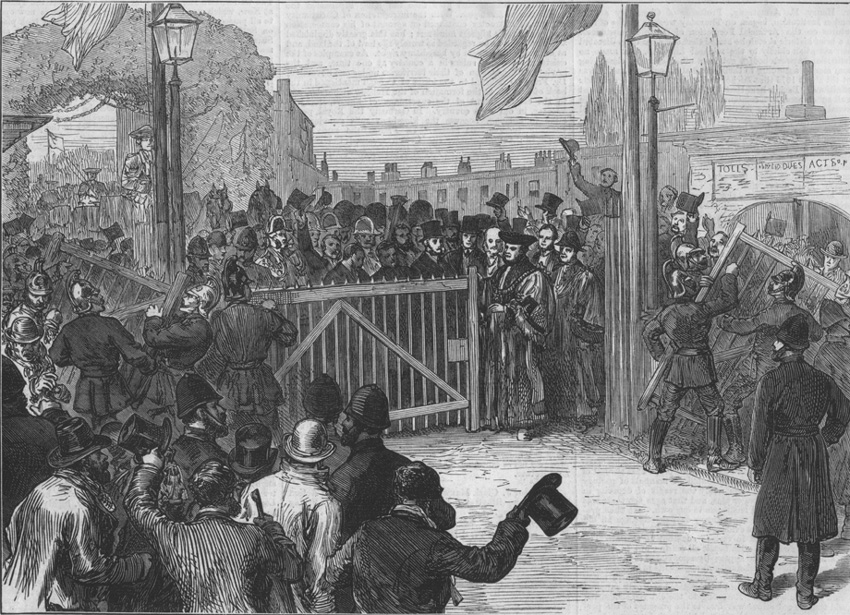 |
| On Saturday 8 February 1873 Kew Bridge was made free of tolls in a grand ceremony with the Lord Mayor of London. This image is from The Illustrated London News of 15 February 1873 showing the view from the north end of the bridge looking north with the procession on the bridge approach ready to cross to Kew. One triumphal arch of evergreens is visible as the Lord Mayor opens the gate and the firemen carry off the barriers on either side. Later the dignitaries had lunch at the Star & Garter and there were fireworks in the evening. The full account of the event published in the Illustrated London News is below. |
FREE OPENING OF KEW BRIDGE. The well-known stone bridge of seven arches over the Thames at Kew, which was built above eighty years ago, is now open to all passengers free of toll. The opening ceremony took place on Saturday last. It was attended by the Lord Mayor and Sheriffs of London, and by Colonel Hogg, M.P., official chairman of the Metropolitan Board of Works. This bridge was private property, vested in trustees, and is the fourth bridge across the upper district of the Thames that has been emancipated within the last few years, mainly by the application of the coal and wine dues of the city of London and the metropolis; the trustees in this case receiving, by way of compensation, £57,300. Kingston Bridge was the first that was freed from toll, in March, 1870, when the venerable Lord St. Leonards, then in his ninetieth year, rode on horseback in the procession, as High Steward of the manor of Kingston. Since then the bridges at Walton and Staines have been emancipated, and it now only remains to free the bridge at Hampton to complete the work in the upper part of the Thames. The watchword in the surrounding districts has of late been “Free bridges for a free people,” which on Saturday was displayed on banners. It is due to Mr. Gould, now an Alderman and formerly Mayor of Kingston-on-Thames, to state that he has taken a conspicuous part in aiding the movement from the first, co-operating for that purpose witch a committee of aldermen and burgesses in that town. By a bill introduced by the Government in May, 1868, it was originally intended to continue the coal and wine duties until 1889 for the purposes of the Thames Embankment and certain City improvements; but that being strenuously opposed by the inhabitants of districts bordering upon the Thames, as the bill then stood, a clause was inserted to the effect that the duties should be applied in the first instance to the freeing from toll the five bridges of Kew, Kingston, Hampton :Court, Walton, and Staines; and in the following year another Act passed empowering a joint committee of the .Corporation of London and the Metropolitan Board of Works to give effect to the provisions of the Act of the previous Session in appropriating the funds derivable from the coal and wine duties in the purchase of the interest in the bridges in question, and throwing them open to the public. Before the ceremony, on Saturday, there was a procession of the Lord Mayor and Sheriffs, in their state carriages, from the Gunnersbury station into the village of Kew. Colonel Hogg was with the Lord Mayor; the procession included the members of the joint committee and of the local committee, all in open carriages. The line of route was filled. with people, and the windows on both sides were crowded. The approaches to the bridge were spanned by triumphal arches, composed of evergreens, and banners floated from both sides throughout the entire length. the Lord Mayor and Colonel Hogg, with the Sheriffs, arriving at the northern entrance to the bridge, they alighted and were received by Mr. Mason, chairman of the trustees. Advancing towards them, Mr. Mason handed the Lord Mayor a finely-worked mediaeval key, highly polished, and ornamented with masonic emblems. The Lord Mayor asked Mr. Mason if he and his co-trustees had received the purchase-money for the bridge, £57,300. A reply having been given in the affirmative, the Lord Mayor, amid rounds of cheering and booming of cannon, unlocked the gate. The firemen rushed forward and, raising the gate from its hinges, bore it in triumph to a brewer’s dray, decked with evergreens and flowers, and drawn by a pair of white horses, driven by a man in a red cap. The firemen having mounted the dray, which became a conspicuous object in the pageant; the journey was continued along the bridge, amid salvos of artillery, and round Kew-green, returning eventually by the bridge to the Star and Garter, at the north end, where a luncheon awaited the chief persons who had taken part in the ceremony. At this Mr. H. Smith occupied the chair, having the Lord Mayor on his right hand and Colonel Hogg, M. P., on his left; Mr. Alderman, and Sheriff White and Mr. Sheriff Perkins, with Mr. Under-Sheriff Crosley, also occupied seats at the principal tables, as did Sir Richard Baggallay, M.P. for Mid-Surrey; the High Sheriff of Surrey; Mr. Glossop, chairman of the Brentford Bench; Mr. Gould, an Alderman of Kingston; Mr. Cross, and Mr. W. Merriman, hon. secretary of the Kew Bridge committee. The Lord Mayor, in his official capacity, took the place of Alderman Sir James Lawrence, M.P., as chairman of the joint committee; the Corporation was represented by Mr. J. T. Bedford, Mr. committee; the Mr. Lawley, Mr. John Papersen, and Mr. Nelson, City solicitor; and the Metropolitan Board by Colonel Hogg, Mr. R. Freeman, Mr. W. H. Lammin, and Mr. John Savage, with Mr. Wakefield, their clerk. In the evening there was a display of fireworks. From The Illustrated London News Saturday 15 February 1873 p.159 |